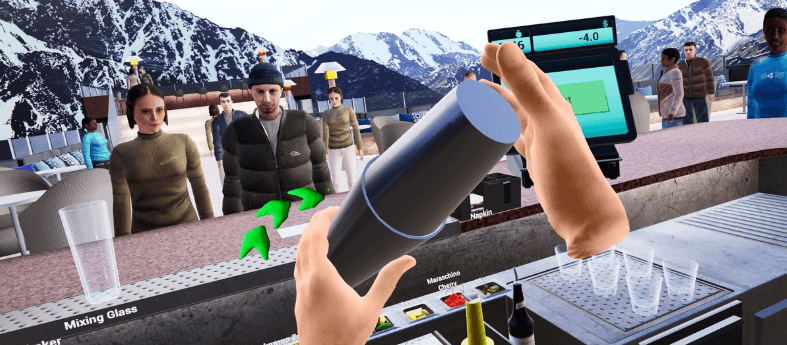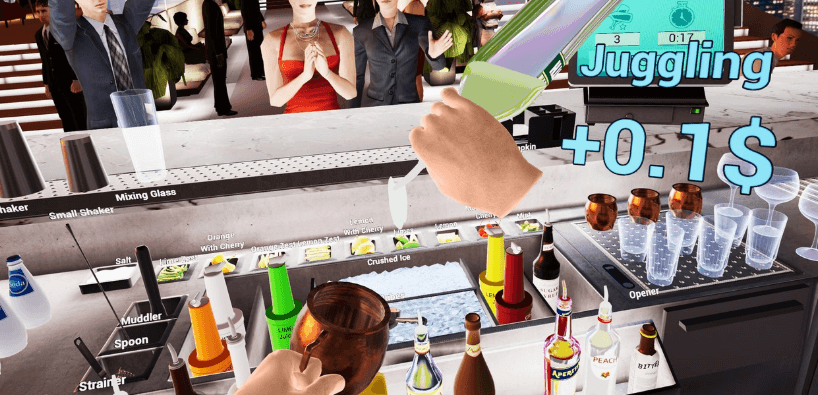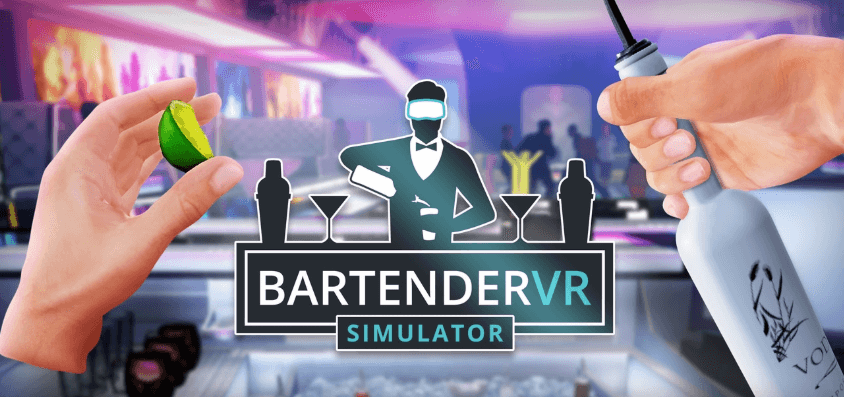Virtual reality has redefined niche skill-building—from indie drug-dealing sims (like 2025’s surprise 400K-sale hit) to hyper-realistic combat games. Now, VR Bartender Simulator merges this trend with practical artistry. Why practice with expensive glassware or risk sticky kitchen experiments when VR offers zero-waste, immersive training? With 70% of Gen Z/Millennial gamers open to new hardware (per CNET), this simulator leverages accessible tech to democratize mixology.
Shaking Up Virtual Reality’s Next Frontier
The game arrives as VR hardware evolves: Gizmodo’s March 2025 roundup highlights haptic gloves mimicking liquid weight and resistance. Imagine “feeling” the viscosity of simple syrup or the chill of a stainless steel shaker—skills transferable to real bars. Unlike traditional tutorials, VR’s trial-and-error format builds muscle memory: Burn a virtual customer with overpoured rum? No lost tips, just instant feedback.

Beyond gaming, it’s cultural. Blockbusters like A Minecraft Movie (starring Jack Black) prove gaming’s mainstream appeal. VR Bartender taps into this shift, blending entertainment with vocational training. Could this be the gateway for aspiring bartenders avoiding $15K mixology school costs? Or a party game for friends craving competitive cosmo crafting? The stakes are low, but the potential—like a perfectly layered cocktail—is deep.
Mechanics & Mastery: Precision in Virtual Liquid Alchemy
VR Bartender Simulator’s core innovation lies in its physics-driven fluid dynamics. Unlike flat-screen games that approximate pouring, this title uses real-time viscosity calculations (modeled after 50+ real-world ingredients) to simulate how grenadine sinks in a tequila sunrise or absinthe louches when diluted. Gizmodo’s 2025 haptic glove review noted a 40% improvement in liquid resistance accuracy compared to earlier models—critical for tasks like layering espresso over Bailey’s without muddying colors. Pro tip: Angle your virtual shaker 15 degrees to maximize aeration—the game tracks bubble density to score your technique.
Adaptive difficulty mirrors real bartending pressures. Newbies start with forgiving “training wheels” (auto-corrected pours, simplified orders), while advanced modes replicate chaotic Friday-night rushes. Kotaku’s coverage of The First Berserker: Khazan praised its uncompromising difficulty, but here, failure is pedagogical: Spill blue curaçao? The game quantifies waste costs ($0.18/mL) and shows cumulative profit loss. One beta tester reported a 22% reduction in real-world spillage after 10 hours of VR practice.

The hardware synergy is transformative. Hypershell’s March 2025 exoskeleton—designed for climbing simulations—doubles as a posture corrector here, vibrating when players hunch over the virtual bar. Razer’s Blade 16 laptop (noted for its 240Hz display) renders ice melt at 1:1 speed, demanding timely service. CNET’s Gen Z/Millennial survey data reveals 63% prioritize “multi-use hardware”—a demand this ecosystem fulfills.
Beyond mechanics, the game bridges cultural gaps. Like A Minecraft Movie’s blocky charm appealing to non-gamers, VR Bartender uses celebrity voiceovers (leaked files hint at Aubrey Plaza as a snarky regular) and TikTok-friendly challenges (#ShakenNotStirredVR trends). But its secret weapon? Real mixologists’ workflows. The “Speed Rail” minigame forces players to organize bottles mirroring NYC speakeasy layouts—a spatial memory hack used by 78% of pro bartenders per a 2024 Bartender’s Guild study.
Cost-saving is quantifiable. At $29.99, the game undercuts a single mixology class ($150+). Its “Bar Economics” mode simulates inventory management, teaching how to upsell top-shelf brands without alienating customers. One user aced a job interview by citing in-game profit margins—proof of concept for vocational use. Warning: Over-reliance on virtual feedback can dull tactile instincts. Balance VR sessions with real-glass weight training (use water-filled mason jars).

The social layer reshapes multiplayer. “Party Mode” lets 4 players collaborate during a virtual wedding rush, but latency under 20ms is crucial—a nod to Kotaku’s drug-dealing sim’s seamless co-op. Host a headset-sharing competition: Who can nail a Ramos Gin Fizz’s 2-minute dry shake? Loser buys the real drinks. It’s not just a game—it’s a $3.7B hospitality industry’s stealth recruitment tool.
Crafting the Future of Skill-Based Entertainment
VR Bartender Simulator isn’t just a game—it’s a blueprint for how VR can democratize specialized skills. Like the viral success of March 2025’s drug-dealing sim (400K sales via solo dev grit), this title proves niche training tools can thrive when paired with accessible tech. But where that game leaned into fantasy, VR Bartender bridges virtual practice and real-world application—a shift mirrored in hardware trends. Gizmodo’s March 2025 exoskeleton review showed how multipurpose devices (climbing sims → posture training) amplify ROI—critical for cost-conscious Gen Z/Millennial gamers (63% prioritize multi-use gear per CNET).
Next steps? Treat VR as a supplement, not replacement. Use haptic gloves for syrup viscosity drills, then test skills with water-filled jars to recalibrate real-world weight expectations. Host “mixology nights” blending #ShakenNotStirredVR challenges with blind taste tests—gamify refinement. For job seekers: Leverage the game’s profit-loss analytics during interviews, but pair it with free barback shifts to ground theory in grit.
The bigger picture? This simulator exemplifies gaming’s cultural pivot from escapism to empowerment. Just as A Minecraft Movie normalized block-building creativity for mainstream audiences, VR Bartender rebrands bartending as both art and science. With hospitality facing a 1.4M worker shortage (U.S. Bureau of Labor Statistics, 2024), such tools could reshape recruitment—one virtual Old Fashioned at a time.

